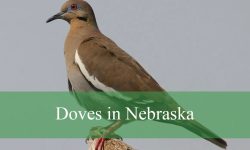Exploring Arizona’s diverse birdlife has always been one of my favorite outdoor adventures. Over the years, I’ve come to appreciate the beauty and variety of finches that brighten up both urban neighborhoods and wild mountain forests. Each finch species has its own unique colors, calls, and behaviors that make spotting them a rewarding experience.
I remember one crisp morning hiking near the Mogollon Rim when a burst of yellow caught my eye—a lively American Goldfinch fluttering among wildflowers. Moments like that remind me how connected these small birds are to the changing seasons and landscapes of Arizona. Whether in a city park or a quiet desert wash, finches add charm and life wherever they go.
In this article, I’ll introduce you to 14 fascinating finch species found throughout Arizona. Along with clear identification tips and vivid photos, you’ll learn where to find them and what makes each one special. If you’re a bird lover or just curious about these colorful little birds, join me on this journey across the Grand Canyon State.
Common Finches You Can Spot in Arizona
House Finch (Haemorhous mexicanus)
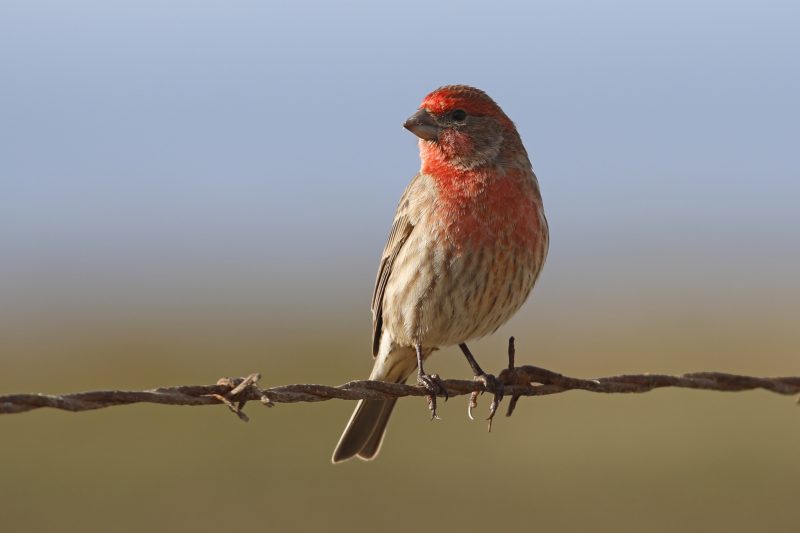
The House Finch is a small songbird commonly found across Arizona, easily recognizable by its vibrant red plumage on the males, especially around the head and chest. Females and juveniles have more subdued brown streaks, making identification possible through their streaky bodies and conical bills. Adult House Finches typically measure about 5 to 6 inches in length with a wingspan ranging from 8 to 10 inches. They have a slightly curved beak suited for their seed-based diet and a cheerful, warbling song.
House Finches are highly adaptable and thrive in urban and suburban environments as well as deserts and open woodlands found in Arizona. They are often seen feeding on seeds, fruits, and occasionally small insects. Their social behavior includes gathering in flocks outside the breeding season, which makes them quite visible around feeders and gardens. These birds nest in a variety of places, including building ledges, shrubs, and trees, often using a loosely constructed cup nest.
A fun fact about House Finches is that they were originally native only to the western U.S. but were introduced to the eastern states in the 1940s when people released cage birds. Since then, they have spread widely and adapted to many habitats, including Arizona’s urban landscapes, becoming one of the most common finches in the region.
Cassin’s Finch (Haemorhous cassinii)
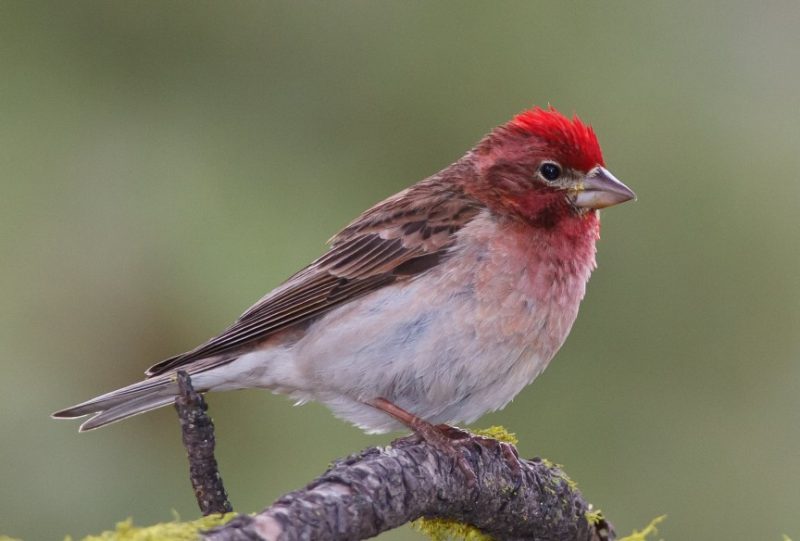
Cassin’s Finch is a medium-sized finch with a distinctive rose-red coloration on the male’s head, breast, and rump, contrasting with a brown back and white streaked underparts. Females lack the red coloring and are mostly brown with streaking, which helps in camouflage. These birds are slightly larger than House Finches, measuring about 6 to 7 inches in length, with a wingspan of around 10 to 11 inches. Their stout, conical bills are perfect for cracking open seeds, their primary food source.
In Arizona, Cassin’s Finches are most commonly found in coniferous forests and mountainous regions, especially during the breeding season. They prefer higher elevations where pine and fir trees provide cover and nesting spots. During the winter, some may move to lower elevations and open woodlands. Their behavior is somewhat shy compared to House Finches, often staying hidden in dense foliage but can be spotted at feeders with sunflower seeds.
An interesting fact about Cassin’s Finch is that they were once considered a variety of the Purple Finch but are now recognized as a separate species. Their song is a rich, musical warble that is often heard echoing through Arizona’s forested mountains in spring, adding to the natural soundtrack of the region.
Purple Finch (Haemorhous purpureus)
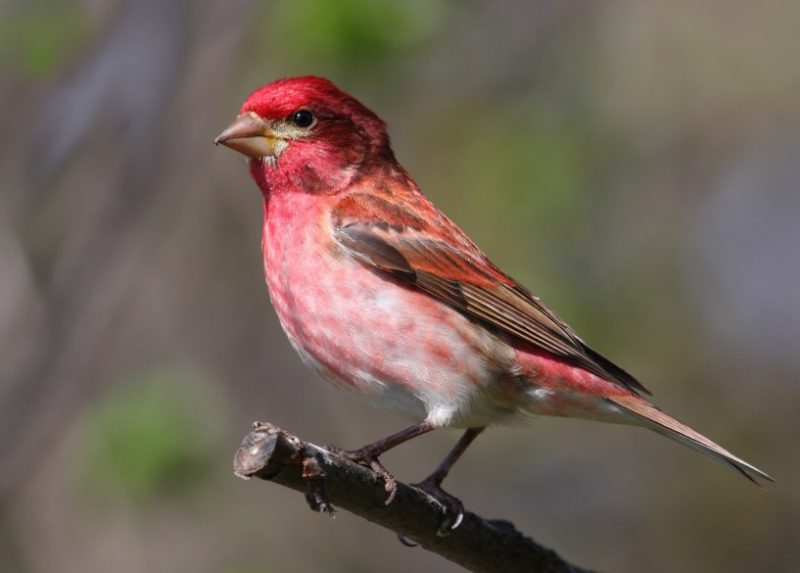
Purple Finches are known for their beautiful raspberry-red coloration that covers the male’s head, chest, and back, giving them a somewhat “purple” sheen, while females have brown, streaky plumage with a white eyebrow stripe. They are similar in size to Cassin’s Finches, about 6 to 7 inches long with a wingspan close to 10 inches. Their thick, conical bill is strong and well adapted to their seed-based diet.
In Arizona, Purple Finches are less common than other finch species and tend to prefer mixed woodlands and forest edges. They are more likely to be seen in northern Arizona’s pine forests rather than the desert regions. These birds are usually solitary or found in small groups outside of breeding season and have a graceful, flowing flight pattern. Their diet consists mainly of seeds, berries, and some insects, particularly in breeding season when protein is needed.
A fun fact about the Purple Finch is that despite their name, their plumage can sometimes appear more reddish or maroon than purple. They have a sweet, warbling song that can be mistaken for that of the House Finch but is generally softer and more musical, adding a lovely auditory experience for birders in Arizona.
American Goldfinch (Spinus tristis)
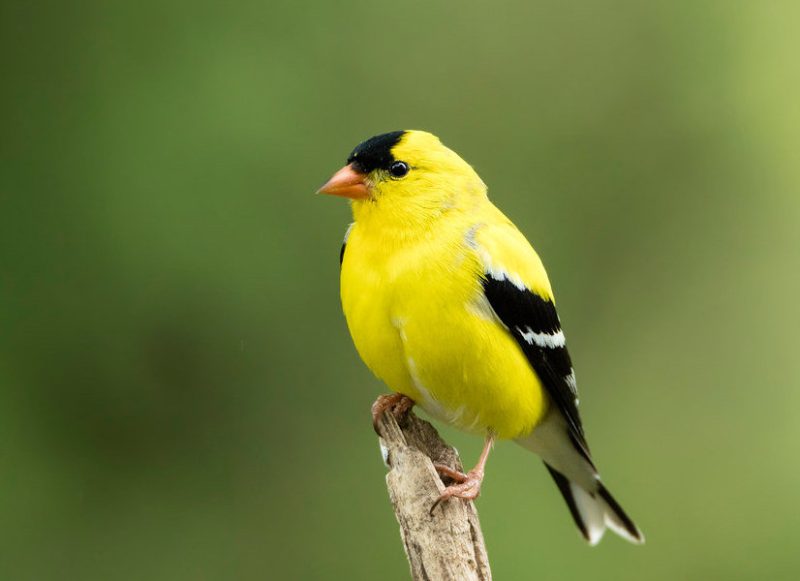
The American Goldfinch is a small, vibrant bird famous for its bright yellow plumage during the breeding season, contrasted with black wings and a black forehead patch in males. Females have a duller yellow color, often olive or brownish. Measuring around 4.3 to 5 inches in length with a wingspan of about 7.5 to 8.7 inches, this finch is one of the smaller members of the finch family. Its pointed bill is perfectly shaped for eating small seeds.
In Arizona, American Goldfinches prefer open fields, meadows, and areas with abundant thistles and other seed-producing plants. They are often seen visiting feeders and are known for their acrobatic feeding style, hanging upside down on seed heads. These birds tend to flock together outside the breeding season, forming large groups that can brighten up any landscape with their striking colors. Their breeding season coincides with the summer months, during which their plumage is at its brightest.
One fascinating fact about American Goldfinches is that they molt twice a year, which is why their colors vary so much between seasons. In the winter, their bright yellow feathers fade to a dull olive, helping them blend into the surroundings better during colder months in Arizona.
Lesser Goldfinch (Spinus psaltria)
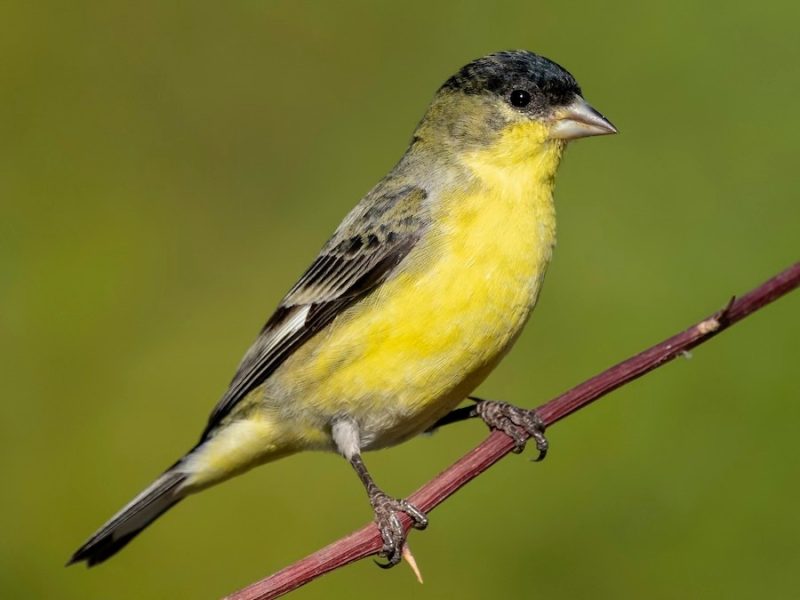
The Lesser Goldfinch is the smallest finch species commonly seen in Arizona, measuring just about 3.5 to 4.5 inches in length with a wingspan close to 7.5 inches. Males boast shiny black backs and wings combined with bright yellow undersides and faces, while females tend to have duller olive-green backs and pale yellow undersides. Their tiny, conical bills are adapted for seed eating, especially favoring smaller seeds.
These finches are highly adaptable and are frequently spotted in Arizona’s desert scrub, gardens, and riparian areas. They thrive in warm climates and are often seen in pairs or small flocks, feeding on seeds from weeds, grasses, and sunflowers. Their behavior is lively and quick, with fluttery flight patterns that make them enjoyable to watch. Nesting typically occurs in shrubs or low trees, where the female builds a delicate cup-shaped nest.
A fun fact about the Lesser Goldfinch is that it is the most common goldfinch in the southwestern United States, including Arizona, where it is often confused with the American Goldfinch. However, their darker backs and smaller size help birdwatchers tell them apart. Their cheerful twittering calls are a familiar sound in many parts of the state.
Lawrence’s Goldfinch (Spinus lawrencei)
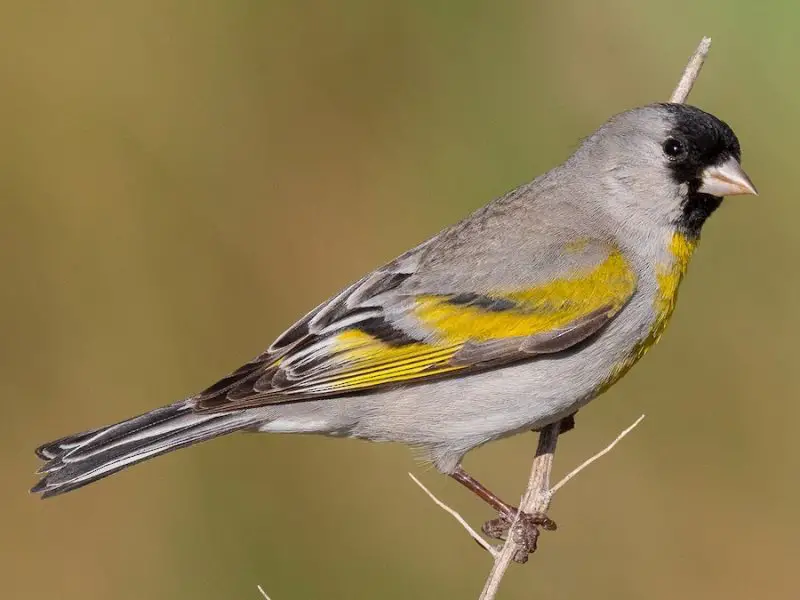
Lawrence’s Goldfinch is a small, delicate finch native to the southwestern United States, including Arizona, known for its subtle yet striking appearance. Males display a soft yellow body with a gray head and black markings around the face and wings, while females tend to be duller with olive-gray tones and less distinct markings. Measuring about 4.5 inches in length, this finch has a slender bill suited for feeding on small seeds and flowers. Their delicate, high-pitched calls are often heard during the breeding season.
In Arizona, Lawrence’s Goldfinches inhabit arid scrublands, chaparral, and foothill regions, preferring open areas with scattered bushes and wildflowers. They are highly nomadic and their presence in any particular area can vary widely depending on rainfall and food availability. These finches often feed in flocks on seeds of native plants like mustard and fiddleneck and sometimes visit feeders. Their breeding season usually occurs in late spring and summer, timed with wildflower blooms.
A fun fact about Lawrence’s Goldfinch is that unlike many finches, they do not sing elaborate songs but rather produce soft, twittering notes. They are considered somewhat elusive due to their irregular appearances, which makes spotting them in Arizona a special treat for birdwatchers.
Pine Siskin (Spinus pinus)
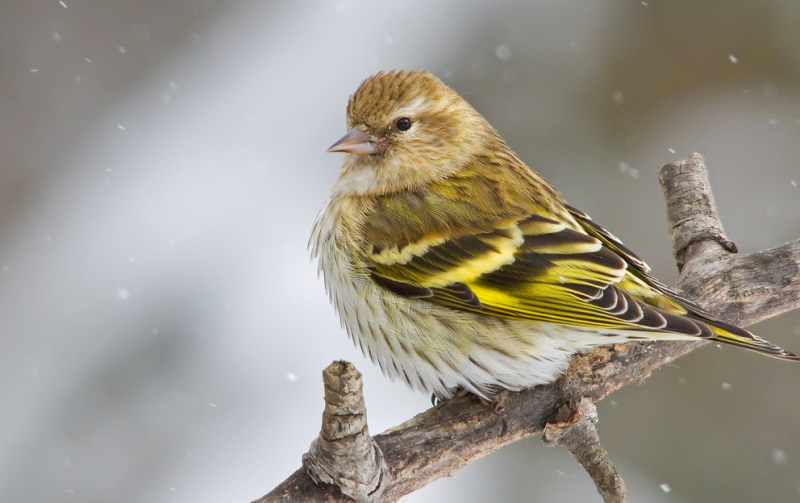
The Pine Siskin is a small, streaky finch measuring around 4.5 to 5 inches in length with a wingspan of about 7.5 to 9 inches. Their brown and heavily streaked plumage with subtle yellow edging on the wings and tail makes them identifiable, especially when in flight. Both males and females look similar, which can make sexing difficult. Their sharp, pointed bill is well suited for extracting seeds from cones and other small plants.
In Arizona, Pine Siskins favor coniferous forests, especially at higher elevations like the Mogollon Rim and northern mountain ranges. They are highly nomadic and often irrupt in large numbers during winters when food is scarce, moving down to lower elevations and sometimes even urban areas. Their behavior includes forming large flocks that noisily forage in trees and shrubs, and they are frequent visitors to backyard feeders, particularly those offering nyjer and sunflower seeds.
An interesting fact about Pine Siskins is their ability to adapt their migration patterns year to year depending on food supply, leading to unpredictable appearances in Arizona. Their buzzy, nasal calls are very distinctive and often heard before the birds are seen.
Evening Grosbeak (Coccothraustes vespertinus)
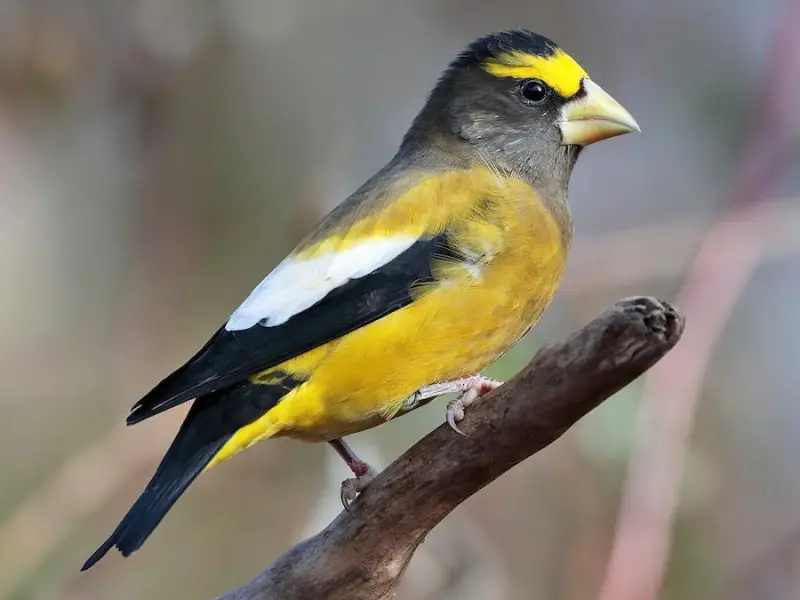
The Evening Grosbeak is a large and robust finch, measuring about 7 to 8 inches in length with a wingspan of up to 13 inches, making it one of the bigger members of the finch family. Males boast bright yellow bodies contrasted with black heads and white wing patches, while females are more muted with olive-yellow tones. Their massive, thick bills are powerful tools designed to crack open hard seeds, especially from conifers.
Though very rare in Arizona, Evening Grosbeaks have been occasionally recorded in the state, usually during irruption years when food sources dwindle further north. They prefer mature coniferous forests in cooler regions and often feed in flocks on seeds and buds from trees like spruce and fir. Their presence in Arizona is usually transient and sporadic, making sightings quite special for bird enthusiasts.
A fun fact about Evening Grosbeaks is that their populations can fluctuate dramatically, sometimes exploding in numbers and then disappearing for years. Their loud, rolling whistles and “chuckling” calls make them quite noticeable even if you cannot see them well.
Red Crossbill (Loxia curvirostra)
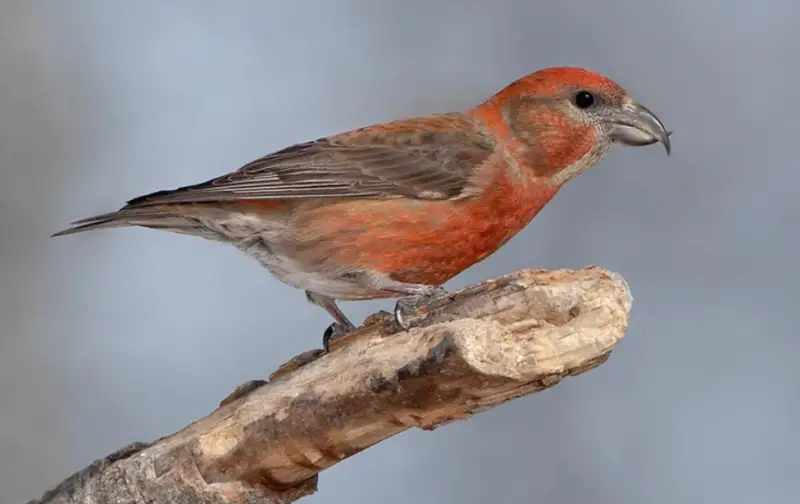
Red Crossbills are medium-sized finches about 5 to 6 inches long with a unique, crossed bill adapted specifically for extracting seeds from conifer cones. Males typically have bright reddish plumage with some orange tones, while females show more greenish or yellowish coloring. Both sexes have strong feet for gripping cones and a robust body suited to their specialized feeding habits.
In Arizona, Red Crossbills are irregular visitors that primarily inhabit high-elevation pine forests where their preferred food—seeds inside pine cones—is abundant. They are highly nomadic and can be found moving in flocks across mountain ranges depending on cone crop availability. Their behavior includes skillfully prying open cones with their unique bills to access seeds that few other birds can reach, an adaptation critical for survival in coniferous habitats.
A fascinating fact about Red Crossbills is their bill shape varies slightly depending on the pine species they feed on, leading to “call types” that researchers use to distinguish populations. Occasional sightings in Arizona are prized by birders due to their specialized niche and striking appearance.
White-winged Crossbill (Loxia leucoptera)
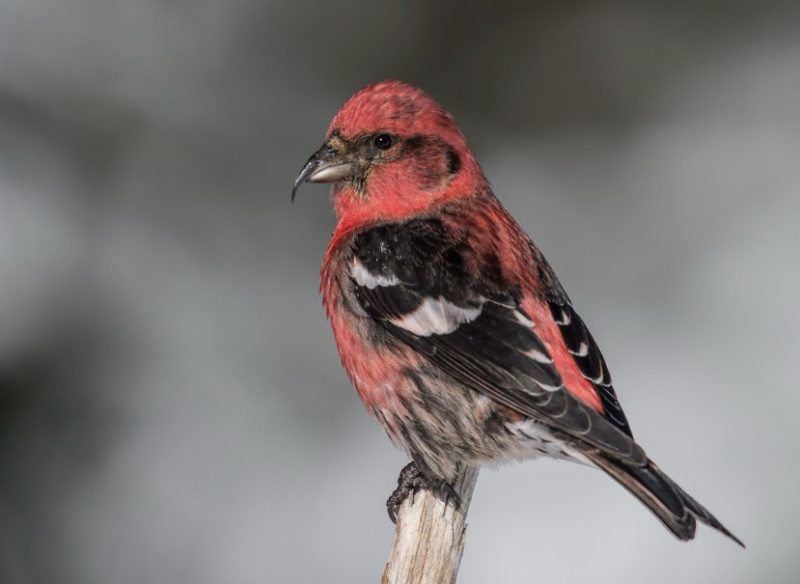
The White-winged Crossbill is a rare and striking finch, measuring roughly 5 to 6 inches in length with a distinctive crossed bill similar to the Red Crossbill. Males are rosy red with bold white wing bars that contrast vividly against black wings and tail, while females display olive-yellow bodies with the same prominent white wing markings. Their powerful bills enable them to extract seeds from conifer cones with impressive efficiency.
In Arizona, White-winged Crossbills are extremely rare visitors, usually appearing only during irruption years when northern food sources are scarce. They primarily breed in boreal forests far to the north, but occasionally wander south into high-elevation coniferous forests in the state. When present, they feed in flocks on spruce and fir cones, often alongside other cone-specialist finches.
A fun fact about White-winged Crossbills is their ability to live in harsh, snowy environments far from Arizona, yet they sometimes make surprising southward journeys. Their loud, metallic “chip” calls are a distinctive sound among forest birds, and spotting one in Arizona is considered a notable birding highlight due to their rarity.
Common Redpoll (Acanthis flammea)
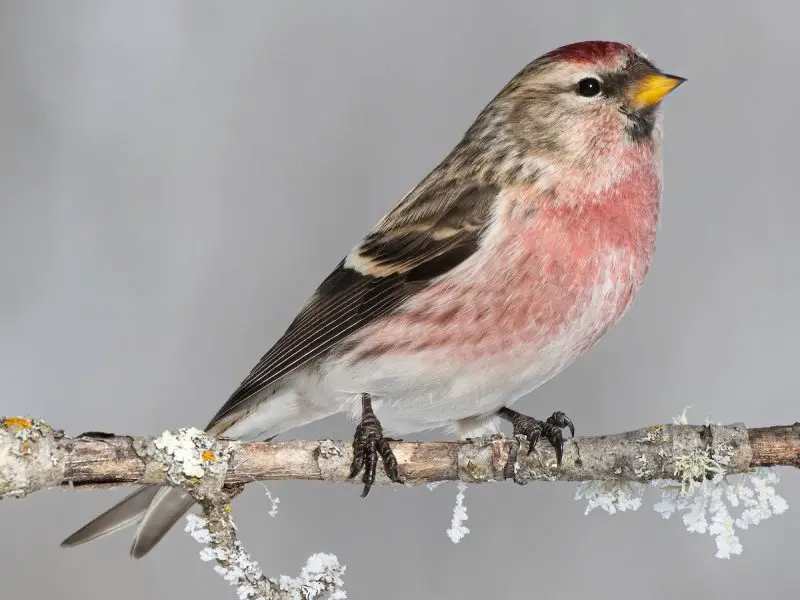
The Common Redpoll is a small, active finch measuring about 4.5 inches in length with a wingspan near 8 inches. Males display a rosy red patch on the forehead and a pinkish wash on the chest, while females are more muted with brown streaks and subtle red markings. Both sexes have a distinctive small, conical bill and a black chin patch. Their plumage is primarily brown and white streaked, blending well with their cold, northern habitats.
In Arizona, Common Redpolls are extremely rare visitors, mostly seen during unusual migration events when northern populations move southward in search of food. These finches prefer cold boreal and tundra environments far from Arizona but occasionally pass through or linger in higher elevations or urban feeders during winter. Their behavior is restless and social, often forming large flocks that forage on seeds and buds.
A fun fact about the Common Redpoll is their unique ability to survive in some of the harshest winter climates, thanks to a specialized throat pouch that stores extra seeds. Spotting one in Arizona is a very special occurrence for birdwatchers given their rarity and typical northern range.
Hoary Redpoll (Acanthis hornemanni)
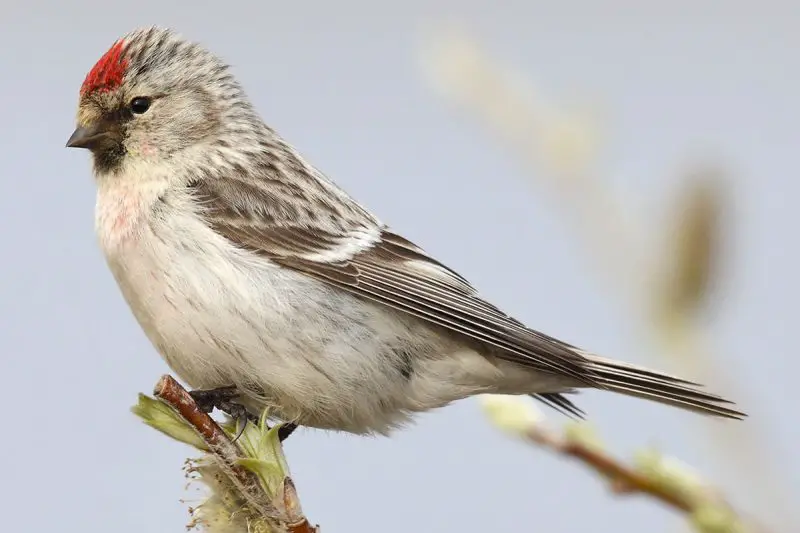
The Hoary Redpoll is similar in size to the Common Redpoll but is distinguished by its paler, almost frosty plumage, giving it a “hoary” or icy appearance. Measuring about 4.5 inches long with a wingspan around 8 inches, the male’s plumage is mostly pale gray and white with faint streaking, a red forehead patch, and a black chin, while females are slightly browner but still much lighter than Common Redpolls.
In Arizona, Hoary Redpolls are exceedingly rare and only seen during irruption years when northern populations migrate unusually far south. Their usual habitats are Arctic and sub-Arctic tundra zones, so their appearance in the southwestern United States is exceptional. When they do arrive, they often visit feeders and mixed flocks with other finches, feeding on small seeds.
A fascinating fact about Hoary Redpolls is that they breed in some of the coldest places on earth, such as northern Canada and Greenland. Their presence in Arizona is so rare that it is considered a major birding event whenever one is found, making them a prized sighting for local enthusiasts.
Eurasian Siskin (Spinus spinus)
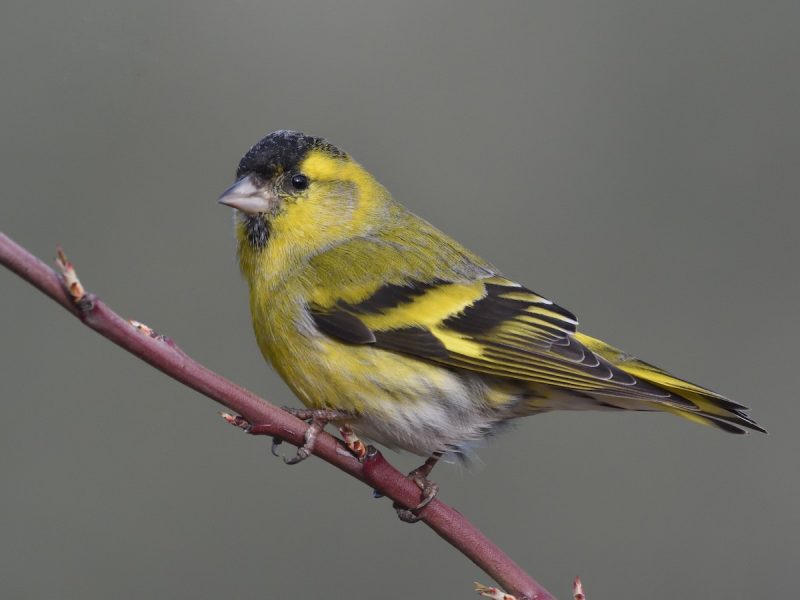
The Eurasian Siskin is a small finch about 4.5 inches long with a wingspan of roughly 8 to 9 inches, featuring a streaky olive-green body with black markings and bright yellow patches on the wings and tail. Males show more vivid yellow and black contrast, while females are duller but still streaked. Their pointed bills are perfectly shaped for extracting seeds from trees like alder and spruce.
This species is a rare visitor to Arizona, mostly seen during rare irruption events when populations move out of their native European and Asian ranges. They tend to inhabit forested areas and are less common in urban settings. When present, they form flocks that forage in trees and shrubs, often alongside other finch species.
An interesting fact about the Eurasian Siskin is that despite being native to the Old World, it has occasionally been recorded in North America, showing the remarkable ability of some finches to cross continents during migration or accidental dispersal. Their lively and musical calls add a distinctive sound to the forests they inhabit.
Greenfinch (Chloris chloris)
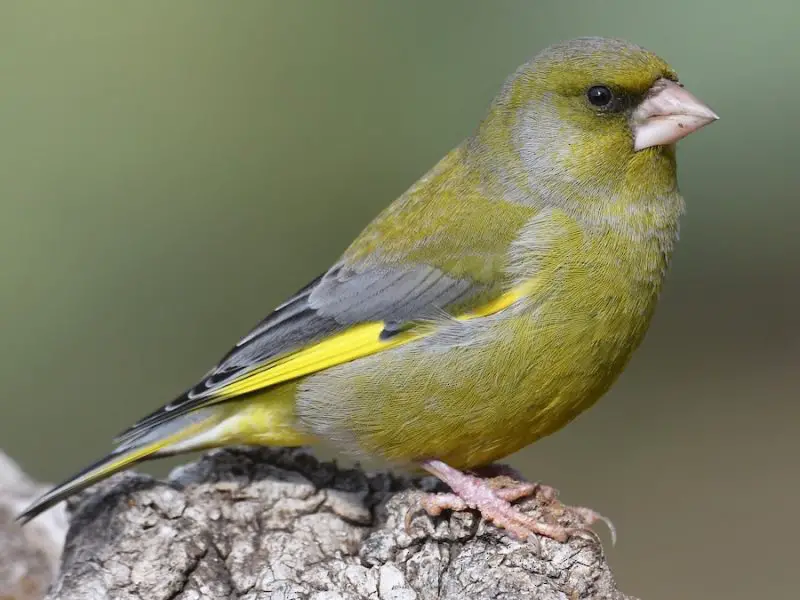
The Greenfinch is a medium-sized finch measuring about 5.5 to 6 inches in length with a wingspan of 9 to 11 inches. Males display bright olive-green plumage with yellow accents on the wings and tail, while females are duller with more brownish tones. Their strong, conical bills are well suited for cracking seeds and nuts. Greenfinches have a robust body shape and a characteristic buzzing flight pattern.
In Arizona, Greenfinches are very rare and mostly found in urban and suburban areas where they have been introduced as an exotic species from Europe. They adapt well to gardens and parks, often visiting bird feeders. Their behavior is sociable and somewhat bold around humans, and they can form small flocks outside the breeding season.
A fun fact about Greenfinches is that they are considered an invasive species in some parts of the world due to their adaptability and competitive feeding habits. In Arizona, their rarity and non-native status make them a curious sight for birdwatchers interested in urban avian diversity.
FAQs about Finches in Arizona
What types of finches are commonly found in Arizona?
Arizona hosts a variety of finch species including the House Finch, Cassin’s Finch, Purple Finch, American Goldfinch, and Lesser Goldfinch. Each species has unique colors and behaviors adapted to Arizona’s diverse habitats from deserts to mountain forests.
Are there any rare finch species in Arizona?
Yes, some finches such as the Evening Grosbeak, White-winged Crossbill, Common Redpoll, and Hoary Redpoll are considered rare or very rare visitors to Arizona. These species often appear only during special migration or irruption years.
What habitats do finches prefer in Arizona?
Finches in Arizona inhabit a range of environments. House Finches and Lesser Goldfinches are often found in urban and suburban areas, while species like Cassin’s Finch and Pine Siskin prefer coniferous forests and mountainous regions. Desert scrub and riparian zones also support several finch species.
Do finches visit backyard feeders in Arizona?
Many finch species, including House Finches, American Goldfinches, and Pine Siskins, frequently visit backyard feeders. They are especially attracted to seeds such as sunflower, nyjer, and thistle, making them popular visitors for bird enthusiasts.
How can I identify finches in Arizona?
Identification usually depends on size, color patterns, and behavior. For example, male House Finches show bright red plumage, while American Goldfinches have vibrant yellow feathers during breeding season. Listening to their distinct calls and observing feeding habits can also help differentiate species.
Are there any non-native finch species in Arizona?
Yes, the Greenfinch is an example of a non-native finch that has been introduced mainly in urban areas. It is rare but can occasionally be spotted in gardens and parks within the state.
What is unique about crossbill finches found in Arizona?
Crossbills such as the Red Crossbill and White-winged Crossbill have uniquely crossed bills that help them extract seeds from conifer cones, a specialized adaptation for their conifer forest habitats. These species are rare in Arizona and are usually seen in higher elevation forests.
When is the best time to see finches in Arizona?
Finches can be seen year-round, but some species like the Pine Siskin and Redpolls appear mostly in winter or during irruption years. Breeding plumage in spring and summer makes many finches more colorful and easier to identify.

